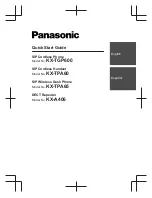
Administration Manual ip500pbxw – English
148
C
IP Addresses, Network Masks & Subnets
IP Addresses
Note
This section refers only to IP addresses for IPv4 (version 4 of the Internet Protocol).
IPv6 addresses are not covered.
This section assumes basic knowledge of binary numbers, bits, and bytes.
IP addresses, the Internet's version of telephone numbers, are used to identify individual nodes (computers or systems) on
the Internet. Every IP address contains four numbers, each from 0 to 255 and separated by dots (periods), e.g.
20.56.0.211. These numbers are called, from left to right, field1, field2, field3, and field4.
This style of writing IP addresses as decimal numbers separated by dots is called
dotted decimal notation
. The IP address
20.56.0.211 is read ‘twenty dot fifty-six dot zero dot two-eleven.’
Structure of an IP address
IP addresses have a hierarchical design similar to that of telephone numbers. For example, a 7-digit telephone number
starts with a 3-digit prefix that identifies a group of thousands of telephone lines, and ends with four digits that identify one
specific line in that group.
Similarly, IP addresses contain two kinds of information:
•
Network ID
Identifies a particular network within the Internet or intranet
•
Host ID
Identifies a particular computer or system on the network
The first part of every IP address contains the network ID, and the rest of the address contains the host ID. The length of
the network ID depends on the network's
class
. The table below shows the structure of an IP address.
Field1 Field2 Field3
Field4
Class A
Network ID
Host ID
Class B
Network ID
Host ID
Class C
Network ID
Host ID
Here are some examples of valid IP addresses:
Class A: 10.30.6.125 (network = 10, host = 30.6.125)
Class B: 129.88.16.49 (network = 129.88, host = 16.49)
Class C: 192.60.201.11 (network = 192.60.201, host = 11)
Network classes
The three commonly used network classes are A, B, and C. (There is also a class D but it has a special use beyond the
scope of this discussion.) These classes have different uses and characteristics.
Class A networks are the Internet's largest networks, each with room for over 16 million hosts. Up to 126 of these huge
networks can exist, for a total of over 2 billion hosts. Because of their huge size, these networks are used for WANs and by
organisations at the infrastructure level of the Internet, such as your Service Provider.
Class B networks are smaller but still quite large, each able to hold over 65,000 hosts. There can be up to 16,384 class B
networks in existence. A class B network might be appropriate for a large organisation such as a business or government.
Class C networks are the smallest, only able to hold 254 hosts at most, but the total possible number of class C networks
exceeds 2 million (2,097,152 to be exact). LANs connected to the Internet are usually class C networks.
Some important notes regarding IP addresses:
The class can be determined easily from field1:
field1 = 1-126: Class A
field1 = 128-191: Class B
field1 = 192-223: Class C
(field1 values not shown are reserved for special uses)
A host ID can have any value except all fields set to 0 or all fields set to 255, as those values are reserved for special uses.
















































